
When you think of toxic mold you likely think of how it effects humans. But did you know that mold can cause terrible health problems for animals? In fact, household mold affects pets even more virulently than humans – dogs, cats, and other small animals are more susceptible to mold-related illness than people due to their less advanced immune systems.
Let’s take a look at how toxic mold affects pets and how to help them recover.
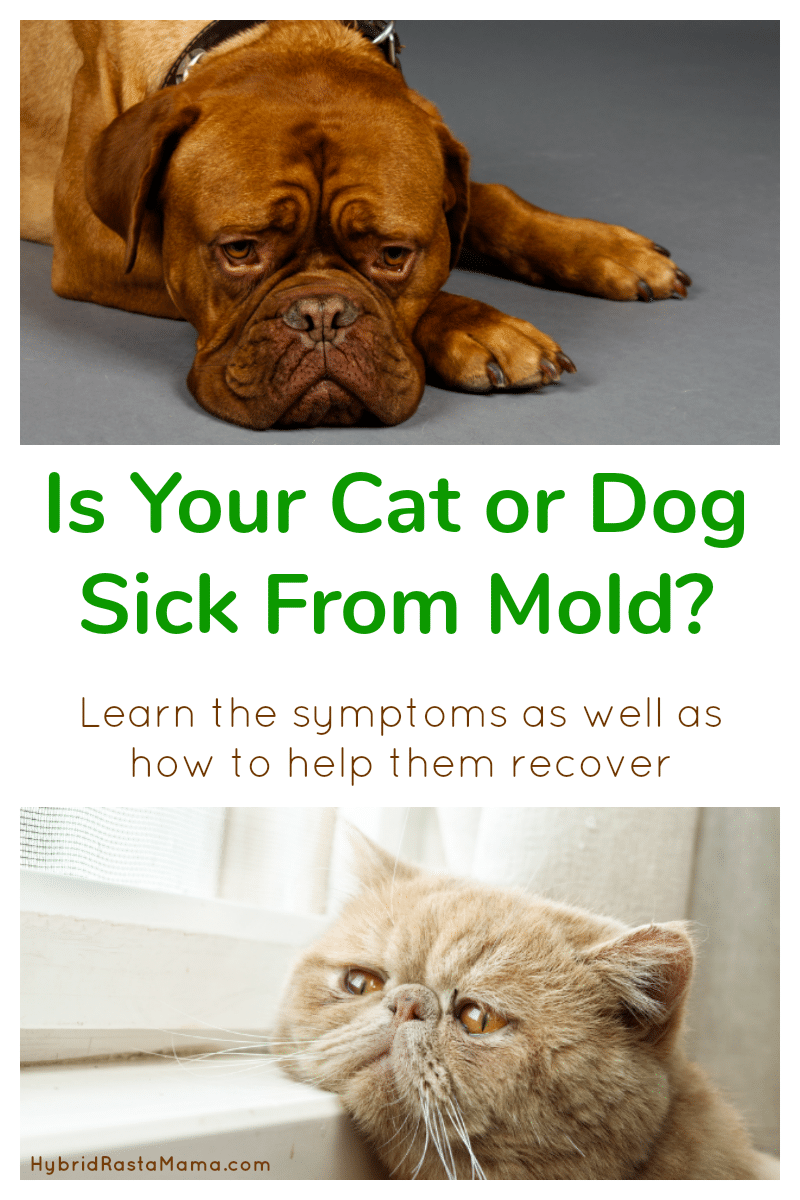
The Discovery – How Toxic Mold Affects Pets
It was a 2007 press release from the American Veterinary Medical Association that really brought the effect of toxic mold on pets to light. Douglas Mader, a Florida veterinarian, was performing a dental procedure on two sibling cats. Soon after beginning the procedure, he noticed frothy blood in the anesthesia tubes. Alarmed, he stopped the procedure. Sadly, the cats both passed away within two days, and blood samples indicated that there was black mold in their lung capillaries. A hemorrhage exacerbated by the procedure was the cause of death. The cats showed no prior symptoms, and the family only discovered after the cats’ blood test that there was mold in their home.
Symptoms of Toxic Mold Exposure In Pets
People discover that they have been exposed to toxic mold in a variety of ways. Sometimes they develop health problems that lead to the discovery, sometimes they physically see the mold in their homes, and sometimes the family pet falls ill.
Prior to the 2007 press release, pets’ symptoms were often attributed to other ailments. We now know that animals can react to inhaled mold spores, ingested mold spores, and mold spores that come in contact with their skin.
The following is a list of the most common symptoms pets exhibit when exposed to toxic mold:
- Severe scratching, licking, biting, and chewing when fleas or other pests are not present
- Rashes
- Hair loss
- Lethargy
- Runny nose
- Runny eyes
- Sneezing
- Wheezing
- Coughing
- Rapid breathing
- Nose bleeds
- Change in eating habits
- Vomiting
- Stool changes
- Weight loss
- Anxiety
Some types of toxic mold also affect the nervous system, which can cause tremors and seizures. These are less common symptoms of mold exposure however.
It’s easy to see why these symptoms were often assigned causes other than toxic mold exposure. They are common to a wide array of health problems that can affect our pets. The severity of the symptoms depends on a number of factors, including the severity of the mold issue and the type, size, and general health of the pet. Sometimes symptoms are so mild that they go unnoticed, and sometimes they lead to death even before the source of the problem is discovered.
Why Is Mold Dangerous For My Pet
Respiratory problems are the most common health issues pets develop as a result of toxic mold exposure. They are also the most concerning. When mold is inhaled by your pet, capillaries in the lungs are weakened by the mold spores. Over time, the capillaries can rupture and hemorrhage. If left untreated, this condition will eventually lead to death. These issues typically progress faster in animals than in humans due to their smaller size.
What To Do If You Suspect Your Pet May Be Sick From Mold Exposure
It’s better to be safe than sorry. If you suspect your pet has been exposed to toxic mold, take all pets in the household to the veterinarian as soon as possible, even if they are not exhibiting symptoms. It is common in multi-pet households that one pet will display symptoms before the others. Typically smaller animals are more quickly and severely affected.
Regardless of how your pet is exposed to toxic mold, if you don’t get veterinary help as soon as possible, it can damage the liver, kidneys, bones, spinal cord and brain.
Veterinary treatment for mold inhalation or ingestion is generally focused on supportive care, including the management of respiratory symptoms, vomiting, and the administering of IV fluids for dehydration from gastric distress.
The veterinarian may prescribe medications (like antifungals or steroids) to help your pet’s symptoms and lesson the immune system’s response to the mold. He or she may also suggest that your pet take an antibiotic to prevent or treat a secondary condition that may occur as a result of your pet’s weakened system.
If the veterinarian determines that your pet is suffering as a result of toxic mold exposure, do not bring your pets back to your home where the mold exists. You may need to board them or find a family member or friend who is willing to take them in while you eliminate the mold problem, a lengthy process.
If your pet will be temporarily staying in a home where there are other pets, it is important to verify with your veterinarian that all of the pet’s symptoms are attributed to toxic mold exposure and not another underlying condition. While health issues from mold exposure are NOT contagious, other conditions with the same symptoms may be. In order to protect all of the animals in the house your pet will be staying, make sure the animal is in good health, otherwise.
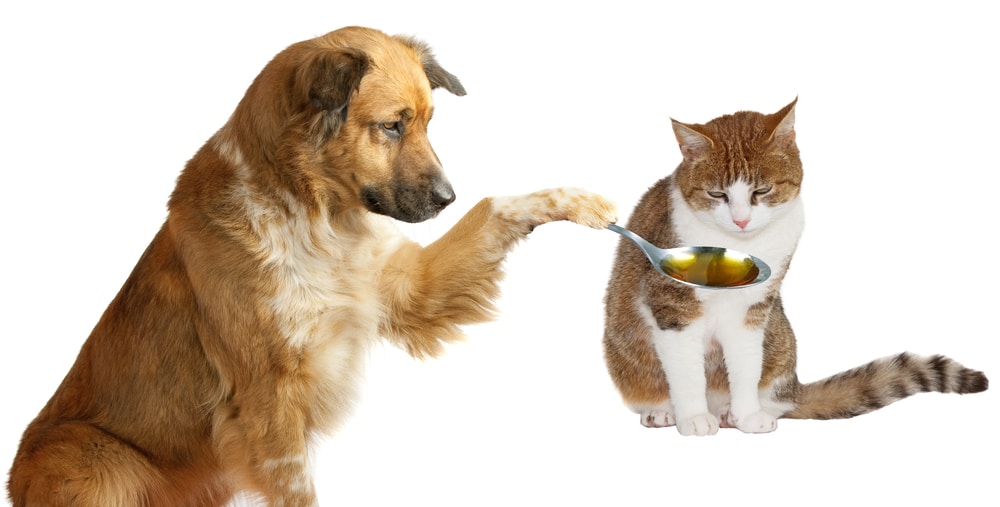
Natural Ways Cats and Dogs Can Detox From Mold Exposure
Since I am not a veterinarian, I am not going to discuss a specific treatment plan. I will share you with several natural ways a cat or a dog can detox from mold exposure and you can then consult with a trusted animal practitioner as to the best way to move forward. I have linked each product to the ones I use and trust.
Natural supplements cats and dogs can take to support them during and after a mold exposure include:
- Activated Charcoal
- Glutathione
- N-Acetyl L-Cysteine (NAC)
- Artichoke extract
- Milk Thistle
- Zeolite
- Detox Gold
- Probiotics
There are also several pet safe products offered by MicroBalance Health Products. Give them a look over.
Clean eating is important!
Your dog or cat should follow a grain free diet during recovery and beyond. Pet food made with grains are notoriously filled with mycotoxins. You can read more about that here. I suggest you feed your cat or dog the I and Love and You brand of pet food. It is super clean and very nourishing.
If you have a rabbit, gerbil, hamster or other small omnivore, be sure you are feeding them an organic diet. In addition, inspect their hay carefully. Hay is a huge carrier of mold spores and mold.
Remediate Your Pets
Yep – you read that right. Just like you would remediate your home or your car from mold, you need to get mold OFF of your pet. Check out my post on How To Remove Mold From Your Pet’s Fur for those details.
How To Keep Your Pets Safe From Mold
- Keep pet food in sealed containers and store them in a cold, dry area
- Wash food and water bowls every day with vinegar and water
- Wash pet toys once a week
- Wash your pet’s bedding in EC3 Laundry Additive once a week
- Clean cages, litter boxes, and accessories on a regular basis
- Don’t give your pet access to the trash or any area where there might be moldy food
- Keep your pet away from moldy environments – crawl spaces, basements, flooded areas, swamps, river banks, etc.
- Practice good mold prevention techniques like these
The Bottom Line On Mold And Pets
If you suspect your pet has been exposed to toxic mold, don’t hesitate to seek veterinary assistance. You may save your pet’s life, and your own.
Are you a pet parent who has dealt with toxic mold? Please share your story.
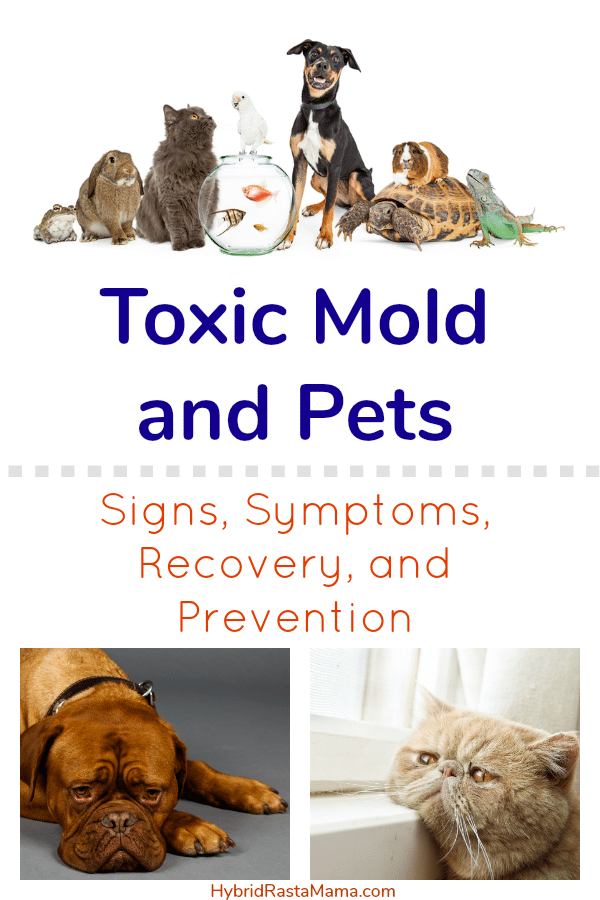



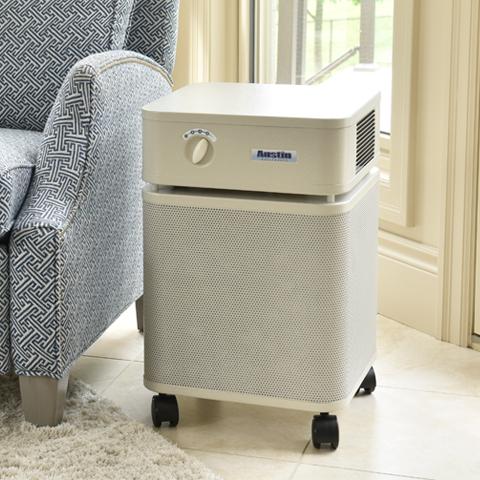

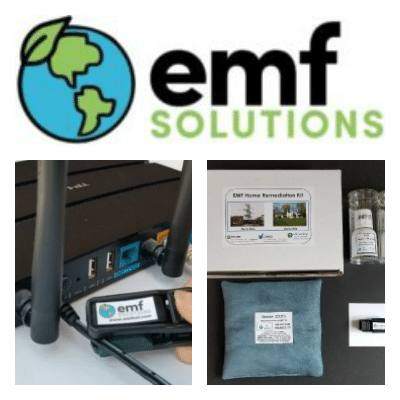


Jane says
My dog has been exposed to Stachybotrys, a black mold. He has had skin issues, a yeast infection in his ear & is now suffering from neck pain that goes down into his front legs. My family & vet do not believe the exposure is causing the symptoms. How can I convince them that the exposure is causing his pain? Are there any tests that can be run to prove it is the Mold that is the cause.
Jennifer says
Hi Jane,
I wish I could point you in the direction of a specific test that proves your fur baby has mold related health issues. Knowing what I know now, I can say with certainty that mold exposure caused our dog’s health issues and ultimately led to his early death. I can only go off of research and not actual testing though. You could do an HTMA (Hair Tissue Mineral Analysis) which will at least show what minerals he is deficient in. This could help you with proper supportive supplementation. I can direct you to the person who can do this test of you would like. She can also offer you suggestions on testing for food sensitivities since those are heightened with mold exposure and could be causing the skin issues and the yeast issues. It is really affordable to do both tests too.
Kristin Rocchi says
My dog suffered for years with the same issues. Then he began coughing and hacking. He’d get overheated we would put a fan on to help him breathe. He colasped one day, loosing contol of his bowels. Parker never pooped inside. We took him to vet at he had either lung cancer or fungal infection in his lungs. He was suffocating. We couldn’t afford the biopsy but regardless he was put down that day. It wasn’t till I saw the mold in our ducts a month later when the connection was made. My 5 yr old twins are sick, I’m loosing my mind and feel like hell everyday. Diagnosed with anxiety depression adhd nonspecific skin rashes yeast infections acne . My husband now has this deep painful cough. I’m going to let the bank take house. I can’t afford to fix it. I can’t afford to move. I let time get away from me. Dont wait. Get to a vet that will listen. A biopsy will show fungus if that’s the culprit. Best of luck to you.
Bridgit Danner says
We found out we had black mold in our house about 6-8 weeks ago. We are currently not living on our old house, and our dog seems much happier. I think this could be bc she has a better view and more light, but my husband thinks it’s bc the mold was making her depressed. Can’t say for sure, but the whole family is much happier to not be in that house.
Richard says
I just found black mold in my dogs house outside and threw it all away he has been on antibiotics for about 25 days he gets better when its my days off and he doesnt go into the dog house now that the doghouse is gone do you thin k he might recover with the mediation
and a new trip to the vet to check for that.
Jennifer says
How old is you pup? Our pets recovered quite nicely and are very healthy. Animals process toxins differently than we do and often recover quicker than humans. Try to support his system with probiotics and lots of fresh veggies like green beans and carrots. The extra fiber will help cleanse his system.
Misti Hopkins says
I have been living in an apartment for 8 years and just recently realized that it has mold. My cat became diabetic and just passed away. I have 2 tiny Chihushus who have been living here for 5 yrs that are displaying strange symptoms but can’t get a diagnosis from vets. They both have skin issues hair loss but skin scrapings come back as no mange. I shine the woods lamp and my little white guy lights up like a Christmas tree. I bathe them with ringworm shampoo from the vet weekly, I foster kittens and they always have ringworm. I am able to cure the kittens but not my puppies. Now my little girl looks swollen. She looks like gaining weight but not eating enough to account for her size. They are both overweight, but this sudden change in size is unsettling.
ready to go to vets now. What are the symptoms of mold exposure? I started to panic after reading that animals can and do become diabetic from exposure. My sweet sweet poor kitty. 🙁
Jennifer says
I am so sorry to hear this! I believe that animals would experience the same symptoms as humans. (http://hybridrastamama.com/name-jennifer-mold-brain/) Animals are much better at hiding things though, especially cats. I would run some basic bloodwork to see if her immune response is elevated. It is so difficult to know with animals! Good to luck to you and your sweet fur babies. I really do feel for you.
Melissa says
I don’t know where to begin. I recently moved from a house in Louisiana (a new house that we lived in for 8 years) to another state. After years of severe, and nearly fatal health problems of my own, it was discovered, $20,000 later, that I have 4 kinds of toxic black mold poisoning along with other molds. It was also discovered that I have a genetic disease that likely caused it. So, since I’ve been sick for almost 28 years, it never occurred to me that the new house we lived in had mold. We never saw it, and we supposedly never had leaks. Wrong!
I have always fostered dogs for local rescues and have 4 of my own, along with 4 kids. One of our dogs (65 lbs.) kept having severe bouts of diarrhea, which was straight blood at times, and he was diagnosed with hemmorraghic gastroenteritis. He also kept having focal seizures and just very odd behavior. This dog has always been sick. We have another dog (75 lbs.) that has mental issues. He’s aggressive with our other large dog and honestly, just odd. We have a hairless (12 lb.) dog with what we assumed was just allergies. Our other dog is a 35 lb. special needs dog. She was born with her back legs fused at the knees, along with many other issues. She eventually had her back legs amputated. One thing we were told, about 4 years ago, is that her lungs were severely underdeveloped. We got her when she was only 4 months old, and we assumed it was a side affect effect of her birth defect. She’s always had trouble breathing, mainly outdoors in the heat though. She and our 65 lb. dog have bad arthritis. He’s 6,and she’s 4. Her arthritis is understandable, but his started at a young age,around 3 yrs old.
Anyway, I don’t know how these dogs survived living in a home with this much black mold, especially the 12 lb. dog. I imagine they have a lot more issues than I’m even aware of. Thankfully, since we moved out of that house just 2 months ago, they have a chance to get better. So far, I have actually gotten worse, but I do have the genetic disease exacerbating it. Two of my kids that had symptoms are already almost symptom free!
My biggest concern is with our 65 lb. dog who continues to have symptoms. I honestly think he has irreversible neurological damage, which is sad. I now have to find a vet to take me seriously about this. I’d already told an internal medicine vet about it, but since he was there due to a massive lipoma, she kind of blew me off. After about $5,000 in vet bills just for the lipoma, we don’t have enough to really do anything else for him, which breaks my heart. We also just found out that our home owner’s insurance will not cover any type of mold remediation due to some weird Louisiana law, so that house (that we still own) may end up a total loss if it’s found in the walls. I forgot to mention that the mold was found, by accident, in our air ducts. We went to have them cleaned, and there was so much mold that they wouldn’t clean them. So, I’m now beginning my research to try to find ways to help our dogs heal without a vets help. Any advice would be greatly appreciated.
Kathrine Paul says
Since I have moved into this house a year and a half ago , I have been hospitalized twice in the past 3 months . I have three dogs one of which began to have skin problems … Chewing and scratching himself til he would bleed …. He stopped eating and his activity was minimal to none …. He started having seizures and came so close to death …. I spent every moment giving him fluids forcefully for days at a time … He did survive but I believe I have black mold in this house … Could this be the cause ? My puppy pixie has showed signs of illness and shakes her head in a strange way like a small seizure
The symptoms of black mold infection in pets range from allergic type sniffles to joint pain and blood clotting problems.
Runny nose
Sneezing
Nosebleeds
Lameness (because of bleeding in the joints)
Skin rashes and sores (on thin-furred areas such as the belly or armpits in pets)
Loss of appetite
Lethargy
Trembling
I have found it here http://www.floodaz.com/how-to-remove-black-mold-without-killing-the-environment/
I need more explanation regarding this what can i do ?
Jennifer says
I am so so sorry to hear this. Honestly, I am not an expert on dealing with toxic mold related health issues in animals. Getting them out of the environment is key of course but as for detoxing them…I haven’t found a good protocol.
Heather says
I live in a 7-bedroom house with 7 roommates, 6 animals, one is mine (a 5-month-old puppy), and two small children. No symptoms, but no one in the house sees the mould as a big deal. The entire inside of the bathroom wall is rotted and covered in black mould and the wall is mushy. The reason they don’t care: they are extremely lazy and don’t feel like dealing with it. I’ve been trying to find another place for months, but it’s so expensive, I can’t afford it. Living with this many people is cheap. I don’t want to call a professional to look st the wall, because I’m scared that the house will be condemned and I literally have nowhere else to live. Any suggestions? I do not want my baby boy to get sick!
Jennifer says
I would try cleaning the mold with this product: http://microbalancehealthproducts.com/products/ec3-mold-solution-spray.html?rfsn=1068079.6c890 I have been testing it out and is seems to work quite well. The wall itself obviously needs to be taken down and replaced. Do you have a landlord or is it one of the roommates? This is a habitability issue that is backed by tenant laws.
Allan Lieberman says
Great article. Thanks for sharing. It’ll really beneficial for those facing problems from toxic mold.
Candace says
Thanks for sharing!
I had a Great Dane pup (Zeus), that had a lot of health issues right after his vaccination. I took him back to the vet, they said he was fine. He continued to have more issues, and I called or took him back. A few times they prescribed antibiotics. Most of the time they told me it was nothing to worry about. I even asked if it was an allergic reaction to anything, and they reassured me that it wasn’t. This went on for 6 months. I got sick of them making me feel like I was crazy, I knew that something wasn’t right, so I made him appointments at 2 new vets, they couldn’t get him in for a week or two. Zeus went into anaphylactic shock 1 week before his first birthday, I took him to an ER Vet, he thought he saved him, but Zeus ended up passing. Probably the worst experience of my life.
The Vet did some X Rays amongst his tests he was running. He said with all the problems I had faced, I should take Zeus down to the Ohio Dept of Agriculture so they can run some tests. I did that. I have the report. After much googling and digging and talking to anyone familiar with the issues or with Great Danes, someone mentioned mold.
I found out our home had a mold problem. I took air cultures (kits you can buy from Home Depot) to send to a lab. Our new puppy was born and was ready to come home. I didn’t want to bring him to the house until I figured out what was going on, but the breeder wouldn’t keep him. Thor lived there for about 3 months. During this time, he was starting to show similar symptoms of Zeus. (I will list below).I mailed the cultures off, and we moved.
Called to follow up on the cultures and they never got them. I am pretty sure it has something to do with the mold because my boys and I have a lot of unexplained health issues too. That’s a whole other story.
What I think Thors Symptoms are:
Medications he takes:
Benadryl, Synacore (Probiotic), Milk Thistle, Quercitin, Turmeric, & RX Vitamins K9 Minerals
– Itching (he does take Benadryl twice a day), if he doesn’t, he is miserable.
– Red between paw pads, licks them all of the time.
– Swollen eyes sometimes.
– Always has a runny nose. Sometimes it bleeds, but not a lot.
– Always has a bright red belly. (he gets a bath every 10 days with Baby Aveeno Collodial Oatmeal Bath, and some kind of Clean Baby soap, it gets better after that, but goes right back)
– Always has bumps on the bottom of his chin that break open and bleed, despite his bowls being cleaned with soap and water before and after he eats, as well as his mouth being wiped with a wet wash cloth after he eats.
– Eats all human food because he can not tolerate dog food. (allergy tests say he’s allergic to storage mites) Food; chicken, beef, or eggs, brown rice, and assortment of veggies and berries. For treats he gets fruits of veggies.
– Hyperkeratosis of the paw pads.
– His nose is starting to look a little different too.
– If he doesn’t take probiotics, he gets missing patches of hair and red welts and bumps on this stomach, as well as “puppy acne” around his muzzle.
– If he doesn’t eat rice, then he has diarrhea and problems with his anal glands.
– He sleeps a ton, could be because of the Benadryl, but I would rather have him sleep, than be as sick as he is when he doesn’t have it.
– His poop always looks like there is some kind of parasite in it, but I’ve had it checked 6 times and they keep telling me it’s fine. When I ask them what it is that I’m seeing, they say, ‘idk, could be rice?!”
He’s been to 4 different vets. I have mentioned the mold to all of them. No one is doing anything, and they think I am overreacting. I can’t shake this feeling, and I’m not going to let someone else tell me it’s nothing just because they are a professional in animal medicine. I know my dog, better than anyone, and I know when something isn’t right. Life should not be this hard for him, and he shouldn’t have to suffer like this.
I just called a 5th vet to make an appointment. What do I have to do to do for someone to listen to my concerns and run tests? I’m guessing they don’t have these kind of tests for dogs? I don’t know. I kind of want to call Genova and see if they can do K9 samples. I desperately need advice, or direction. Please help us.
Jennifer says
Hi Candace! Oh this is a lot! I am so sorry that both you and your pup are going through this. It might be better to chat on email because there could be some back and forth. Shoot me an email through my Contact page if you would like to do that. For now – I reached out to my practitioner who does a LOT of holistic work with dogs. She said she is going to put some feelers out for you on this. She did mention that a lot of people just send in dog urine instead of human urine to test for mycotoxins. I can give you that info if you want to run that test. I notice you do not have Zeus on a binder. This is very important to help get the mold out. Have you tested your current living environment? If you brought your “stuff” from the other home, you may have cross contamination happening. Also vaccines + mold are a bad combo so there could be something to that. AND you live in Lyme country which could be a factor. Lyme and mold seem to find each other. Anyway, reach out on email so we can talk more. I think this will get a little long for a comment thread. 😉
Dana says
Dealing with all oF this right now with my bulldogs. Have you ever found any help or solid advice, or even someone that will listen?
Susan Emily says
Pets and children and the most susceptible to mold spores. Unfortunately, these are the ones that can’t explicably explain to us that something is wrong and if so, what that could be. Mold is still a subject which so many people are inexperienced in (trust me I work at one) so finding all this resource you have here is a blessing to everyone that can benefit from your experiences and knowledge. Kudos Jennifer.
Dana says
Hi. I have 3 English bulldog rescues all which showing signs of mold poisoning. I, myself have, as well. We lived in apartment infested with stachy (15 months). I made the mistake of cross contaminating to my new apartment so we pretty much have been living in this crap for about 20 months altogether. The dogs are getting worse (we have been at an Airbnb for the last few days).. I’m so worried. I’m in the parking lot of the emergency vet as we speak as my youngest (3) couldn’t walk or
Even stand up this evening. He wouldn’t stop panting. I brought him here they check for an obstruction, nothing. I know it’s the mold. They have seen 3 vets in the last 8 months and I brought this up to all 3 with concerns and was blown off every time. I need help. I can’t let these dogs suffer.. and I won’t let them just die.
They are all I have after this. My own family has stopped talking to me because they don’t understand. Do you have any advice? Tia. ~one concerned bulldog mama
Jennifer says
Hi Tia! Do you have an Integrative Vet in your area? They typically take a more holistic approach to vet care and often times are willing to run different tests and to look at what is going on. English Bulldogs are tricky because they already have potential respiratory difficulties due to their breed.
Alex Sutton says
This is so good to read! We’ve been worried about finding a little bit of mold in our home, but we didn’t even consider how it might affect our pets. We will definitely be finding a mold remediation expert ASAP so none of us get sick, or sicker then we might already be. Thank you so much for the information!
Amanda Fisher says
my almost two year old American bully XL and just passed away August first of last year (2023).
he did have parvo but since he’s passing we realized we had i a severe case of black mold!!!
it was floor distilling in our spare room behind our washer and dryer in our room below the window and in the corners and in the closet it was everywhere once we realized what we had we saw it. we have since cleaned it painted ripped up the carpet and put new flooring down it makes me very sick, as I am highly allergic to it. I have not been to the doctor I did go to the hospital and they act like they didn’t and couldn’t understand what I was saying like I was speaking a different language when I was talking about the black mold exposure. once I realized that we have black mold I obviously got on the internet and did everything I could to educate myself further about black mold and dogs deaths. I believe with all my heart that my dog cuz he was strong and healthy but he developed neurological problems and he slept all the time just many different things but I see looking back now was from him being exposed to black mold. I couldn’t afford to have any testing or anything done I buried him myself cremated in myself because I read that it could live in the ground with a very pet that had it for up to 9 years and I didn’t want any future pets to get parvo so in that we completely cleaned our house top to bottom every inch of everything every item every fabric item was washed and here 8 months later we got a new puppy and he was so lively and happy and playful and now we’ve taken me that once I knew it was mold and I told her that it was mold and she believed me in me and prescribed him an antibiotic. we first started taking it he did very well he started having tremors and seizures he hasn’t had any gastrointestinal issues as of yet but he’s having a lot of neurological and physical as far as like his balance and he seems confused it seems like it’s exactly what I went through with my previous dog Junior but it is happening far more rapidly than with Junior cuz Junior was almost two my new puppy is now 11 weeks so far has symptoms are difficulty breathing, confusion, head swelling, and balance(sometimes he walks like he’s drunk or real slow he’s falling down a few times he seems very weak. he’s on the antibiotic but he’s getting worse and I am as well. I previously went to hotel and stayed for 3 weeks while they cleaned and redid the house and I felt great I felt wonderful until I came back I got really really sick I left again and came back this time with my puppy and he was not just like any signs or symptoms of black mold exposure until we took him to the storage where we have things that we have not yet cleaned and I myself felt like I was going to pass out I was severely busy all the same symptoms within a minute of walking in there so I frantically searched around for him and got him out of there and right after that is when he started having the tremors and a seizures and not waking up very unresponsive and lethargic wouldn’t drink he would eat but would not drink water until I got him bottled water so I’m assuming that it’s in the water cuz he refused absolutely refused to drink and he was thirsty but he would not he will not drink of that class at water also when we first got him his first two baths he loved his third bath he really was frantic and terrified in the water and nothing has happened to him regarding water so I’m wondering if he can sense or smell or taste that it’s in the water which I’ve been saying all along nobody believes me because I have a lot of neurological issues emotional issues physical issues I have a lot of issues regardless black mold because affected me very deeply and they don’t believe me and they think I’m just being overprotective and a reacting with my new puppy because of what happened to Junior even though that that describe the puppy medication for an allergy to black mold I still am having a hard time getting anyone to do anything to help me cuz I cannot work I have nowhere else to go to take my puppy I take them outside often to get fresh air but it’s outside too. the past two days he every time he goes outside unless it’s really really cold he won’t come in even when it was really cold I went back to getting me sitting there shivering and like powering away from me not want me to pick him up and bring him back in the house which I had no choice but to do because it’s far too cold for him outside. I don’t know what to do I have researched and researched on the internet for help and there just isn’t anywhere that will help me with my puppy and I don’t have family I don’t have no one really but my puppy and my boyfriend who really refuses to believe even though he’s affected by the black mold as well he thinks because you can’t see it anymore then it’s gone and that’s just simply not true and I don’t know what to do to show him that severe as an emergency he’s 11 weeks old he’s not going to be able to make it very long continuously being exposed to the black mold I can continue to give him medicine but if he’s continuously exposed he’s not going to get well and he, my boyfriend, and I need help I need help quickly before my puppy dies I don’t have anywhere to go to take him I don’t have any money I don’t have a vehicle I don’t have any resources and I’m very very sick myself I get dizzy I get shaky I get crazy in my mind I hear things I’m confused I get very tired there’s one particular room that had the most mold in there and that’s where most of my things are stored and when I go in there I have to wear a mask and you can’t see any black mold but I come out of there and it seems like I don’t know how to explain it besides like I’m high off the mold I’m really tired and confused my eyes get heavy I really severe circulation issues most times like one hand will be burning hot on the other hand will be as cold I can’t feel my feet I can’t feel my hands they always feel like they’re asleep I have no appetite my mouth is always dry my nose is always running my eyes are always running it’s hard to breathe my chest hurts constantly my bones hurt especially my spine and my neck I could smell it but No One believes me they think I’m crazy I don’t know what to do I was reading all the comments and posts and I was just helping someone could give me some advice of what to do with my puppy mostly I know I’m probably going to be okay but he doesn’t have time his seizures are getting worse he’s sleeping longer and longer it’s getting harder and harder to wake him up he’s still eating well but he’s not drinking very well I’m scared and I feel alone and I need help so can somebody please please help me I’m going to give my phone number just in case someone might be able to know what to do 309-863-9942. please any advice any help any anything to save my puppies life.
his name is lucky he’s 11 weeks old he’s American bully American Shepherd terrier and I believe myself 🙂 beagle!!!☺️
please we need your help!!!!